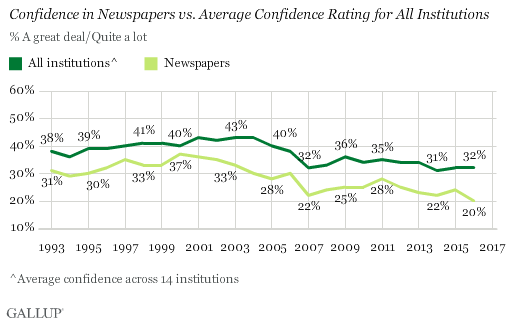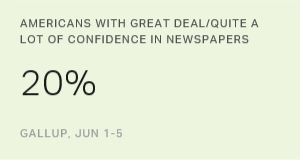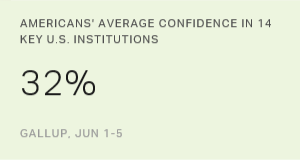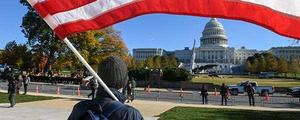Story Highlights
- More in U.S. have low (36%) than high (20%) confidence in newspapers
- Democrats, young adults no longer confident in newspapers
- Decline for newspapers mirrors pattern for 14 major institutions
PRINCETON, N.J. -- The 20% of Americans who are confident in newspapers as a U.S. institution hit an all-time low this year, marking the 10th consecutive year that more Americans express little or no, rather than high, confidence in the institution. The percentage of Americans expressing "a great deal" or "quite a lot" of confidence in newspapers has been dwindling since 2000, and the percentage expressing "very little" or "none" finally eclipsed it in 2007. The percentage with low confidence has only expanded since, tying a previous high of 36%.

One in five U.S. adults now say they have a great deal or quite a lot of confidence in newspapers -- the all-time low for newspapers in Gallup's trend dating to 1973. An additional 42% of U.S. adults say they have "some" confidence, meaning that the institution still sparks at least a measure of confidence in a majority of Americans.
However, the days when more than twice as many Americans expressed high rather than low confidence in newspapers are long gone. While this was common from the inception of Gallup's confidence in institutions trend through 1990, it has only been achieved once since -- in 2002, during the aftermath of the 9/11 attacks when Americans rallied around most major U.S. institutions.
Newspapers Lose Vote of Confidence From Democrats
Historically, Gallup has found that Democrats, including independents who lean Democratic, are more likely than Republicans and Republican leaners to have a significantly better view of newspapers. That has held true even as confidence in newspapers among both groups has fallen over the past 16 years. This is the first year, however, that Democrats' confidence is no longer net positive: 27% have little or no confidence in newspapers, slightly exceeding the 25% saying they have a great deal or quite a lot of confidence. By contrast, Republicans' views toward the institution have tilted negative since 2004.
| Republican/Lean Republican | Democratic/Lean Democratic | ||||||||||||||||||||||||||||||||||||||||||||||||||||||||||||||||||||||||||||||||||||||||||||||||||
|---|---|---|---|---|---|---|---|---|---|---|---|---|---|---|---|---|---|---|---|---|---|---|---|---|---|---|---|---|---|---|---|---|---|---|---|---|---|---|---|---|---|---|---|---|---|---|---|---|---|---|---|---|---|---|---|---|---|---|---|---|---|---|---|---|---|---|---|---|---|---|---|---|---|---|---|---|---|---|---|---|---|---|---|---|---|---|---|---|---|---|---|---|---|---|---|---|---|---|---|
| 2016 | -33 | -2 | |||||||||||||||||||||||||||||||||||||||||||||||||||||||||||||||||||||||||||||||||||||||||||||||||
| 2015 | -25 | 7 | |||||||||||||||||||||||||||||||||||||||||||||||||||||||||||||||||||||||||||||||||||||||||||||||||
| 2014 | -25 | 5 | |||||||||||||||||||||||||||||||||||||||||||||||||||||||||||||||||||||||||||||||||||||||||||||||||
| 2013 | -29 | 2 | |||||||||||||||||||||||||||||||||||||||||||||||||||||||||||||||||||||||||||||||||||||||||||||||||
| 2012 | -23 | 12 | |||||||||||||||||||||||||||||||||||||||||||||||||||||||||||||||||||||||||||||||||||||||||||||||||
| 2011 | -19 | 17 | |||||||||||||||||||||||||||||||||||||||||||||||||||||||||||||||||||||||||||||||||||||||||||||||||
| 2010 | -26 | 10 | |||||||||||||||||||||||||||||||||||||||||||||||||||||||||||||||||||||||||||||||||||||||||||||||||
| 2009 | -25 | 13 | |||||||||||||||||||||||||||||||||||||||||||||||||||||||||||||||||||||||||||||||||||||||||||||||||
| 2008 | -20 | 9 | |||||||||||||||||||||||||||||||||||||||||||||||||||||||||||||||||||||||||||||||||||||||||||||||||
| 2007 | -25 | 12 | |||||||||||||||||||||||||||||||||||||||||||||||||||||||||||||||||||||||||||||||||||||||||||||||||
| 2006 | -14 | 18 | |||||||||||||||||||||||||||||||||||||||||||||||||||||||||||||||||||||||||||||||||||||||||||||||||
| 2005 | -10 | 15 | |||||||||||||||||||||||||||||||||||||||||||||||||||||||||||||||||||||||||||||||||||||||||||||||||
| 2004 | -11 | 23 | |||||||||||||||||||||||||||||||||||||||||||||||||||||||||||||||||||||||||||||||||||||||||||||||||
| 2003 | 12 | 24 | |||||||||||||||||||||||||||||||||||||||||||||||||||||||||||||||||||||||||||||||||||||||||||||||||
| 2002 | 10 | 24 | |||||||||||||||||||||||||||||||||||||||||||||||||||||||||||||||||||||||||||||||||||||||||||||||||
| 2001 | 5 | 26 | |||||||||||||||||||||||||||||||||||||||||||||||||||||||||||||||||||||||||||||||||||||||||||||||||
| ^ % None a volunteered response | |||||||||||||||||||||||||||||||||||||||||||||||||||||||||||||||||||||||||||||||||||||||||||||||||||
| Gallup | |||||||||||||||||||||||||||||||||||||||||||||||||||||||||||||||||||||||||||||||||||||||||||||||||||
Young adults aged 18 to 34 have consistently been the most positive of all age groups about newspapers as an institution. However, the broader decline in confidence has finally reached the point that young adults are more likely to say they have very little or no confidence in newspapers than to say they have high confidence. This year marks the second straight year that newspapers are running a significant confidence deficit among young adults.
| 18 to 34 | 35 to 54 | 55+ | |||||||||||||||||||||||||||||||||||||||||||||||||||||||||||||||||||||||||||||||||||||||||||||||||
|---|---|---|---|---|---|---|---|---|---|---|---|---|---|---|---|---|---|---|---|---|---|---|---|---|---|---|---|---|---|---|---|---|---|---|---|---|---|---|---|---|---|---|---|---|---|---|---|---|---|---|---|---|---|---|---|---|---|---|---|---|---|---|---|---|---|---|---|---|---|---|---|---|---|---|---|---|---|---|---|---|---|---|---|---|---|---|---|---|---|---|---|---|---|---|---|---|---|---|---|
| 2016 | -5 | -23 | -18 | ||||||||||||||||||||||||||||||||||||||||||||||||||||||||||||||||||||||||||||||||||||||||||||||||
| 2015 | -7 | -17 | -8 | ||||||||||||||||||||||||||||||||||||||||||||||||||||||||||||||||||||||||||||||||||||||||||||||||
| 2014 | 6 | -12 | -23 | ||||||||||||||||||||||||||||||||||||||||||||||||||||||||||||||||||||||||||||||||||||||||||||||||
| 2013 | 4 | -19 | -20 | ||||||||||||||||||||||||||||||||||||||||||||||||||||||||||||||||||||||||||||||||||||||||||||||||
| 2012 | 13 | -8 | -21 | ||||||||||||||||||||||||||||||||||||||||||||||||||||||||||||||||||||||||||||||||||||||||||||||||
| 2011 | 15 | -12 | -7 | ||||||||||||||||||||||||||||||||||||||||||||||||||||||||||||||||||||||||||||||||||||||||||||||||
| 2010 | 24 | -26 | -11 | ||||||||||||||||||||||||||||||||||||||||||||||||||||||||||||||||||||||||||||||||||||||||||||||||
| 2009 | -1 | -2 | -15 | ||||||||||||||||||||||||||||||||||||||||||||||||||||||||||||||||||||||||||||||||||||||||||||||||
| 2008 | 18 | -7 | -14 | ||||||||||||||||||||||||||||||||||||||||||||||||||||||||||||||||||||||||||||||||||||||||||||||||
| 2007 | 9 | -6 | -15 | ||||||||||||||||||||||||||||||||||||||||||||||||||||||||||||||||||||||||||||||||||||||||||||||||
| 2006 | 10 | -5 | 5 | ||||||||||||||||||||||||||||||||||||||||||||||||||||||||||||||||||||||||||||||||||||||||||||||||
| 2005 | 10 | -5 | 6 | ||||||||||||||||||||||||||||||||||||||||||||||||||||||||||||||||||||||||||||||||||||||||||||||||
| 2004 | 12 | 2 | 2 | ||||||||||||||||||||||||||||||||||||||||||||||||||||||||||||||||||||||||||||||||||||||||||||||||
| 2003 | 32 | 14 | 5 | ||||||||||||||||||||||||||||||||||||||||||||||||||||||||||||||||||||||||||||||||||||||||||||||||
| 2002 | 30 | 15 | 9 | ||||||||||||||||||||||||||||||||||||||||||||||||||||||||||||||||||||||||||||||||||||||||||||||||
| 2001 | 26 | 13 | 10 | ||||||||||||||||||||||||||||||||||||||||||||||||||||||||||||||||||||||||||||||||||||||||||||||||
| ^ % None a volunteered response | |||||||||||||||||||||||||||||||||||||||||||||||||||||||||||||||||||||||||||||||||||||||||||||||||||
| Gallup | |||||||||||||||||||||||||||||||||||||||||||||||||||||||||||||||||||||||||||||||||||||||||||||||||||
The decline in public confidence in newspapers since 2000 is part of a larger pattern of decline in Americans' confidence in U.S. institutions. However, since 2000, confidence in newspapers has fallen more steeply than the average of 14 institutions Gallup has tracked annually since 1993. While average confidence across all 14 institutions fell from 40% in 2000 to 32% the last two years, confidence in newspapers fell from 37% to 20% over the same period.
Confidence in newspapers was at a peak in 2000, after climbing between 1993 and that year. However, even compared with 1993, confidence in newspapers has fallen more than the 14-institution average.

Bottom Line
Over half of Americans maintain at least some confidence in newspapers as a U.S. institution, but the percentage expressing high confidence -- the kind that counts -- has dwindled to 20%. The percentage with low confidence is now close to twice that rate. This reflects a downturn in confidence among all age and party groups to the point that young adults and Democrats, who once expressed solidly positive confidence in newspapers, are now neutral or net negative.
The public's mood over the past 16 years has been something of a whirlpool, pulling most major U.S. institutions underwater, but newspapers appear to be faring a bit worse than average. The rise of digital media could be a factor in the trust Americans place in a traditionally print medium such as newspapers, but perhaps more importantly, newspapers are suffering from the broader decline Gallup sees in Americans' trust in the mass media in general.
Survey Methods
Results for this Gallup poll are based on telephone interviews conducted June 1-5, 2016, on the Gallup U.S. Daily survey, with a random sample of 1,027 adults, aged 18 and older, living in all 50 U.S. states and the District of Columbia. For results based on the total sample of national adults, the margin of sampling error is ±4 percentage points at the 95% confidence level. All reported margins of sampling error include computed design effects for weighting.
Each sample of national adults includes a minimum quota of 60% cellphone respondents and 40% landline respondents, with additional minimum quotas by time zone within region. Landline and cellular telephone numbers are selected using random-digit-dial methods.
Learn more about how the Gallup Poll Social Series works.


